
HISTORY
In J.R.R Tolkien’s book The Lord of the Rings, there is a chapter where the Hobbits meet Treebeard. Pippin, one of the Hobbits mentions a hill and Treebeard responds by saying that it is a hasty word for something that has stood there for such a long time. Trying to fit the history and development of the 303 British in one or two paragraphs almost describe that statement perfectly and cannot do justice to a rifle and cartridge that has been in military service for almost a century and has shaped so much of World history. The works by Labbett & Mead, B.A. Temple and others give a detailed discussion of this venerable old warhorse so I will try to do a short synopsis here. In the beginning I did not really think much about collecting the 303 British, except for the South African part of its history and maybe a few representative specimens. The more I read about the 303 however, the more fascinating this cartridge became, so here goes…
The American Civil War was considered a turning point in the evolution of modern warfare and most European nations and their respective military decision makers followed events very closely. Several points became clear, the most important being the muzzle loading concept was over and the era of the breech loading rifle had arrived. Military powers throughout Europe suddenly found themselves with large quantities of antiquated rifles and to them it made more economic sense to convert these to breech loading rifles than to start designing something new from scratch. The British Army’s answer to the problem was the 1866 Snider conversion, but as with the French, Dutch, the Danish, the Swiss and others, these were always going to be short term stopgap measures. Although the Snider was replaced in 1871 by the Martini Henry rifle, it still was not ideal as the single shot rifle was almost obsolete the moment it was adopted, something the Italians also concluded they should have done differently.
Considering that communication was not as quick as it is now, a military committee might find that the enormous resources they just spent on a new development was already made obsolete by their neighbour last month. Two such developments that changed warfare irrevocably were firstly Nicolaus von Dreyse’s development of the bolt action mechanism, perfected by the Mauser brothers, and secondly the ability to attach a magazine, converting a recently obsolete single shot rifle to a modern repeating rifle. The one major development that was still to be incorporated was the invention of smokeless powder in 1886 by French chemist Paul Marie Eugène Vieille. So the conventional thinking during the mid-1870’s to early 80’s was still that the .40-inch/11mm bullet diameter was the optimal bullet for black powder, the Germans with their successful M.71 Mauser rifles and the British special committee of 1869 with their .4-inch rifle, with its own set of problems.
It was in June 1885 that the attention of the special committee was drawn to a new rifle/cartridge development from Switzerland, namely the Rubin with its small-bore bullet design. A rifle and ammunition were procured for testing and the preliminary feedback was favourable, with further official testing requested. The French at this stage were testing and adopting their Lebel Rifle, and in early 1887 a modified Rubin rifle with the magazine modified in front of the trigger guards was submitted to the committee by Greenwood & Batley. Reports were in favour of the new rifle, but the case was changed from rimless to rimmed and the case diameter increased. The Rubin cartridge was also changed to a bottlenecked case because of problems with the brass split neck ring. The idea was also to adapt the new cartridge to smokeless powder, but at that stage Britain did not have a suitable propellant to use. Cordite was only invented later in 1889 so the first pattern of cartridge adopted in February 1889 still used black powder.
Sources:
Temple B. A., (1986) Identification Manual on the .303 British service Cartridge – No:1- Ball Ammunition
Temple B. A., (1986) Identification Manual on the .303 British service Cartridge – No:2- Blank Ammunition
Temple B. A., (1986) Identification Manual on the .303 British service Cartridge – No:3- Special Purpose Ammunition
Edwards A.O., (2011) Headstamp Guide: .303 inch British Service Ammunition. Solo Publications. ISBN 978-0-9568528-0-9
Labbett P. & Mead P.J.F., (1988) .303 inch, A History of the .303 Cartridge in the British Service. ISBN-0-9512922-0-X
Harding, C.W., (2012) British Cartridge Manufacturers, Loaders and Retailers. Quiller Press
BALL AMMUNITION
There were ten principal marks of .303 ball rounds with an additional four approved marks of short-range practice.
BLACK POWDER MARK I
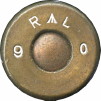

The first pattern to be approved in February 1899 was the “CARTRIDGE SA BALL MAGAZINE RIFLE MARK I”. Loading was black powder with CN bullet. Unfortunately with age, the case had cracked and only the bottom half remained.
BLACK POWDER MARK II
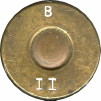

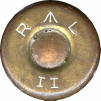

Problems were encountered with the Mark I with bullet and jacket separation, and therefore the Mark II was approved in July 1890 as “CARTRIDGE SA BALL MAGAZINE RIFLE MARK II”. with thicker jacket. The loading was still black powder with CN bullet.
CORDITE MARK I
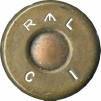

With the invention of cordite in 1889 by Sir James Dewar and Sir Fredrick Able, the use of cordite loaded ammunition was approved in November 1891 and the new cartridge was designated “CARTRIDGE SA BALL MAGAZINE RIFLE CORDITE MARK I”
CORDITE MARK II
The use of Boxer primers was phased out with the Mark I and from July 1893 onwards, the use of Berdan primers were standardised on 303 ammunition. The designation was changed to “CARTRIDGE SA BALL MAGAZINE RIFLE CORDITE MARK II”.
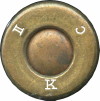

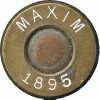

OTHER – BALL/EXPERIMENTAL AMMUNITION
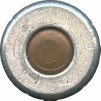

Experimental aluminium case, From an old IAA Forum query, British Aluminium might have been the supplier of the metal, but made by either Birmingham Metals & Munitions, Radway Green or Kynoch
BLANK
The first category is the black powder blank without bullet and consisted of three different patterns.
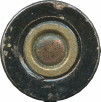

The first pattern was approved on the 7th of April 1890 as the “CARTRIDGE SA, BLANK, .303-INCH MARK. I C. ROLLED CASE” and was also the first pattern blank for the .303 service cartridge as well as the only service load with Boxer primer. It was introduced for the magazine rifle, but the design was impractical because it could only be used in single load. It was declared obsolete on the 1st of March 1893 and replaced with a blank with paper bullet.
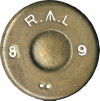

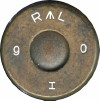

The second pattern was approved on the 28th of November 1894 as the “CARTRIDGE SA, BLANK, .303-INCH BLACK POWDER, WITHOUT BULLET, MARK II C. SOLID CASE converted from ball and blank with paper bullet.” This pattern converted black powder ball cartridges and black powder blanks with paper bullets to a rose crimped blanks resembling the pattern IV and V cordite blanks. It is distinguished however by the headstamps, showing the old black powder cases with boxer primer.
The third and last pattern was the “CARTRIDGE SA, BLANK, .303-INCH BLACK POWDER, WITHOUT BULLET, MARK III. SOLID CASE converted from ball and blank with paper bullet”. It was approved on the 24th of March 1898 and declared obsolete on the 1st of January 1903. The design was strange as it was approved as a black powder loading while other marks of blanks were already using cordite. It is distinguished by the mark code III stamped on the base. Unfortunately I do not have a specimen (yet).
MACHINE GUN BLANK
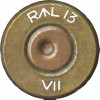

With the outbreak of World War 1, it was quickly realised that the machine gun was going to play a much larger role in this and any future conflict. More guns were needed and more men to operate them, so the need arose for a blank to be used in training for the Maxim and Vickers guns. The cartridge adopted in September 1914 was the “CARTRIDGE M.G. BLANK, .303-INCH, MARK I L.” Standard ball cases were used, but the cartridge had an extended, reduced diameter neck with an oblique mouth, the idea being to constrict the gases from the burning powder to cycle the heavier guns. It was not a successful design, although it remained in service until declared obsolete on the 31st of December 1927.
DUMMY – DRILL AND INSPECTOR AMMUNITION
Dummy/Drill rounds were widely distributed to troops for weapons training and dry-fire practice. The configuration of these rounds was similar to actual rounds but were distinctly marked so as not to be confused by the real thing. According to Labbett & Mead, p.181 a total of eleven patterns were approved for service, which includes one Canadian pattern authorised for use by British troops. Inspector dummies on the other hand were issued to arms factories and repair shops, not to troops for training purposes. Inspection rounds used an inert filler so the weight would resemble that of a live round, but also distinctly marked as such. A total of seven different patterns were approved for service.
DRILL MARK. I
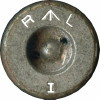

The first Dummy Drill cartridge was issued in February 1890 as the “CARTRIDGE SA DUMMY DRILL MAGAZINE RIFLE MARK I”. Original ball cases were used but later production at Woolwich used new cases which were Berdan primed and headstamped specifically for drill cartridges, as can be seen from the above specimen. This happened after July 1893, as this was the date of approval for the Mark 2 ball rounds that first utilised Berdan primers.
DRILL MARK. 2
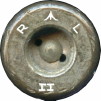

With the Mark 1, the bullet was soldered into the case, but tended to loosen with use, so the “CARTRIDGE SA DUMMY DRILL MAGAZINE RIFLE MARK II” was introduced that only differed in that the neck was coned/crimped as well as soldered.
DRILL MARK. 3
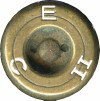

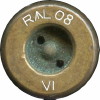

In 1903 a new dummy drill cartridge was introduced using a boxwood bullet instead of the hollow metal bullet, as the “CARTRIDGE SA DUMMY DRILL .303 INCH MARK III” and although cheaper to manufacture, it proved unsuitable for machine gun training. The round nosed bullet shape resembled the Mark 2 and Mark 6 ball ammunition, with earlier versions still having tinned cases with plain wooden bullet but from 1907 onwards the bullets were dyed red. From February 1905 onwards two holes were drilled through the case at right angles and cases were no longer tinned.
DRILL MARK. 4
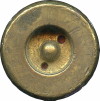

With the introduction of the Mark 7 ball ammunition with spitser bullet, the drill dummy was subsequently changed to reflect this. The “CARTRIDGE SA DUMMY DRILL .303 INCH MARK IV” was introduced in November 1910.
OTHER
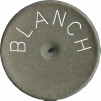

With the large number of recruits to be trained, there was a shortage of dummy rounds to be used in training. The specimen above was an order of around 5 million rounds from the firm of J. Blanch & Sons of Fenchurch Street, London. The case consisted of a rolled tin plate with the base soldered on. These were issued for training although never adopted officially by the Army. The cases proved too fragile, and no further orders were placed. Not many survived and the Blanch dummy is considered rare today.
